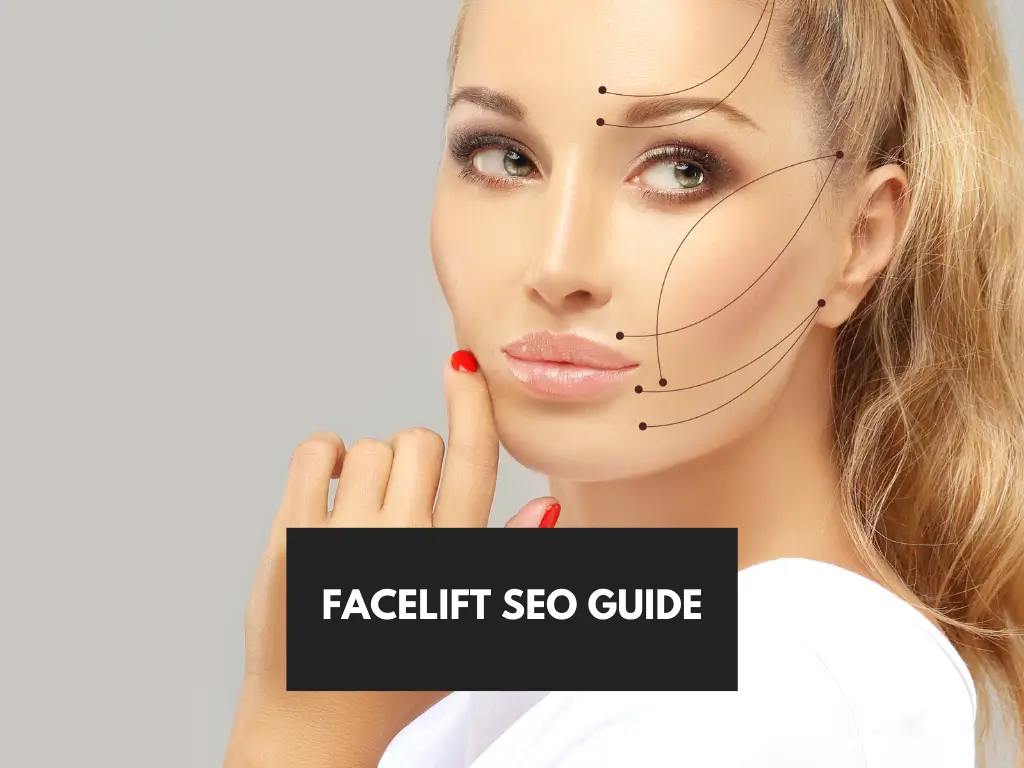Facelift procedures, also known as lifting facial or rhytidectomy are steadily rising in demand. Estimates suggest that global monthly search queries for “facelift” hover around 100,000 or more, depending on the region, while more specific phrases like “rhytidectomy recovery” and “lifting facial cost” also see notable search volumes, often in the 10,000 to 20,000 range. Clearly, there is a robust opportunity to attract potential patients online if your content targets the right keywords.
Yet, due to growing competition, simply mentioning the word “facelift” once on your website is not enough. You need a nuanced SEO strategy that aligns with how patients research facial rejuvenation procedures at different ages and stages. Below is an advanced guide that highlights each step of the process, while keeping the language simple and actionable.
Market Analysis & Opportunity
Many clinics see facelifts (sometimes referred to as lifting facial or rhytidectomy) as a cornerstone of their practice. According to industry projections, the global facelift market is on track to surpass $5.2 billion by 2028. Below are some reasons why:
Global Facelift Market Insights
- Steady Growth: The demand is fueled by improvements in surgical techniques, offering more natural-looking results with shorter recoveries.
- Wider Age Range: Patients in their late 30s to 60s+ are considering different forms of face-lift procedures. Younger individuals may seek a mini facelift (or partial lifting facial) for early signs of aging, while older patients often desire a more comprehensive rhytidectomy.
Age Demographics and Trends
- Early 40s: Patients may look for minimal interventions combined with injectables.
- 50s: More pronounced facial sagging often leads them to a standard or deep-plane facelift.
- 60s+: Comprehensive approaches, sometimes combined with eyelid or neck lifts, are common.
Competition Analysis in Plastic Surgery
The plastic surgery sector is saturated, with many clinics offering “facelift,” “lifting facial,” or “rhytidectomy” services. This calls for a specialized SEO approach that sets your practice apart through unique selling points—like innovative techniques, personalized care, or proven research. For more insights on competing in a busy market, see How to Rank for Plastic Surgeon Near Me, which details strategies for high-competition keywords.
Types of Facelift Searches
A typical monthly search volume for core keywords like “facelift” can exceed 100,000 worldwide. However, patients also look for more specific or alternative terminology.
Traditional vs. Mini Facelift Terms
- “Full Facelift” or “Traditional Facelift”: Users might seek details on the standard rhytidectomy approach.
- “Mini Facelift”: This term resonates with those wanting a less invasive procedure. Monthly searches for “mini facelift” can range from 20,000 to 40,000 globally, depending on the season.
Non-Surgical Alternatives Searches
- Queries like “liquid facelift,” “facelift without surgery,” or “thread lift” are growing.
- These users often prioritize minimal downtime and lower costs, signaling interest in partial improvements rather than a full rhytidectomy.
Age-Specific Queries
- “Facelift at 40”: People at this stage want to address early sagging.
- “Facelift at 50”: Here, potential patients are dealing with moderate skin laxity and deeper wrinkles.
- “Facelift at 60”: Searches often include related topics like combining neck lifts or dealing with more extensive aging.
By dividing these terms into separate service or blog pages, you can capture a wider audience. This approach aligns with the concept of user intent, helping you rank for both general and niche terms related to “facelift,” “lifting facial,” and “rhytidectomy.”
Facelift SEO Keyword Performance Data
SEO Performance Analysis by Facelift Procedure Type
This data compares search volumes, competition levels and conversion rates across different facelift procedures to help optimize your SEO strategy.
| Procedure Type | Monthly Search Volume | Keyword Difficulty | Target Demographics | Conversion Rate |
|---|---|---|---|---|
| Traditional Facelift | 40,000 | High (65-75) | 50-70, affluent areas | 2.5-3.5% |
| Mini Facelift | 20,000 | Medium (45-55) | 40-50, urban areas | 3.8-4.5% |
| Deep Plane Facelift | 15,000 | Low (25-35) | 45-65, luxury market | 1.8-2.2% |
Regional Market Competitiveness for Facelift SEO
Analysis of regional differences in digital marketing competitiveness, costs, and market opportunities for facelift services.
| Region | Competitive Index | Average CPC | Market Saturation |
|---|---|---|---|
| Northeast US | High (85%) | $12.50 | 78% (Highly Saturated) |
| West Coast | Very High (92%) | $15.20 | 85% (Saturated) |
| Midwest | Medium (65%) | $8.40 | 45% (Growing) |
| South | Low (45%) | $6.80 | 35% (Emerging) |

Patient Journey Optimization
An effective SEO strategy for facelift services must guide potential patients throughout their decision-making process. People typically move through three core stages: awareness, consideration, and decision.
Awareness Stage Content
- Anti-Aging Comparisons: Offer blogs comparing different techniques (e.g., facelift vs. injectables, or rhytidectomy vs. “liquid facelift”).
- Surgical vs. Non-Surgical Options: Outline clear pros and cons to help novices learn.
- Age-Appropriate Solutions: Mention how a mini facelift can address concerns for someone in their 40s, while a full rhytidectomy might benefit older patients.
Consideration Stage
- Technique Comparisons: Deep-plane facelift vs. SMAS facelift, or partial lifting facial for targeted areas.
- Recovery Expectations: Include realistic timelines (usually 2-4 weeks for a standard facelift, sometimes less for mini versions).
- Cost-Benefit Analysis: Mention average costs in your region; specify that actual prices may vary based on complexity.
Decision Stage
- Surgeon Selection Criteria: Board certifications, years of experience, and real patient testimonials.
- Financing Options: Give potential clients info about payment plans or medical financing.
- Consultation Preparation: Offer a checklist of questions and what to expect when meeting your team.
For a more thorough look at shaping each stage, check the SEO Patient Journey Mapping for Plastic Surgeons article, which dives deeper into matching content with each phase of the patient journey.
Visual Content Strategy
Images and videos are crucial for facelift promotion. They clarify potential results, build trust, and can rank well in image or video searches if optimized.
Before/After Gallery Best Practices
- Age Group Categorization: Sort galleries by 40s, 50s, and 60s+ so viewers relate better to posted results.
- Procedure Type Filtering: Group images of full rhytidectomy vs. mini face-lift or lifting facial.
- Mobile-First Gallery Design: Ensure swiping through photos is simple. High-resolution images with short loading times are key. For more guidelines, see Plastic Surgery Before and After Photos: The Ultimate Guide.
Here’s an example of a facial rejuvenation journey from Dr. Kristina Tansavatdi, a board-certified facial plastic surgeon based in California who specializes in natural-looking results. She regularly shares educational content about recovery processes on her YouTube channel.
Video Content Optimization
- Patient Journey Videos: Show short clips highlighting day-by-day recovery or interview a patient at different milestones.
- Technique Explanations: Use animations or 3D models to demonstrate how a facelift (or rhytidectomy) addresses sagging.
- Recovery Documentation: Practical tips (sleep positions, timelines, aftercare) to set realistic expectations.
- SEO Tip: Add relevant tags and keywords like “lifting facial procedure” or “facelift recovery timeline” to help search engines categorize your videos.
Age-Specific Landing Pages
Multiple landing pages dedicated to different age brackets can significantly improve your engagement and search visibility.
40s Preventive Measures
- Emphasis: Subtle approaches like mini facelifts, early signs of aging, combination with injectables.
- Content Hook: “Slow down early aging” or “Gentle refresh without major downtime.”
50s Optimal Timing
- Emphasis: Addressing moderate to deeper wrinkles, possibly with a standard facelift.
- Content Hook: “Reclaim a youthful contour” or “Balancing a busy life with surgery.”
60s+ Comprehensive Solutions
- Emphasis: A full rhytidectomy with potential add-ons (eyelid surgery, neck lift).
- Content Hook: “Holistic rejuvenation,” “A second lease on confidence.”
Technical Considerations
Technical SEO can significantly influence your search engine rank, especially for competitive terms like “facelift,” “lifting facial,” and “rhytidectomy.”
Schema Implementation
- Age-Specific Rich Snippets: Mark up pages like “Facelift at 50” so users see quick highlights in search results.
- Recovery Timeline Markup: Show typical healing phases in a structured data format.
- Cost Range Structured Data: Provide approximate price ranges (e.g., “Mini facelift starts at $X” to “Deep-plane rhytidectomy up to $Y”) so Google can list it in search previews.
For a more detailed walkthrough, see Schema Markup Plastic Surgery Guide, which explains how structured data can give your pages an SEO boost.
User Experience Factors
- Age-Appropriate Design Elements: Large fonts, easy-to-read color contrasts, and clear navigation.
- Mobile-Friendliness: Given that a large share of searches come from mobile devices, ensure your site loads fast and is easy to navigate on a phone or tablet.
- Accessibility Features: Provide alt text for images, caption your videos, and use headings properly. This approach benefits users of all ages and can help with ranking. If you need additional pointers, check out Mobile-Friendly Website Plastic Surgeon Guide.

Medical Authority Building
Google’s algorithms heavily weigh a site’s expertise and trust, especially for medical topics like a rhytidectomy or lifting facial.
Clinical Research Content
- Long-Term Results Studies: Summaries or infographics about facelift durability over 5, 10, or 15 years.
- Comparison Studies: Show how your method differs from other approaches, citing credible medical journals.
- Innovation in Techniques: Discuss new technologies or advanced suture methods that reduce scarring or recovery time.
Expert Positioning
- Surgical Specialization: Highlight fellowships, publications, or speaking engagements at conferences.
- Advanced Techniques: If you have training in deep-plane lifts or endoscopic procedures, detail these.
- Teaching/Training Credentials: Mention if you mentor other surgeons or offer workshop demonstrations.
To strengthen credibility, consider reading the E-E-A-T Optimization Plastic Surgery Medical Authority Guide, which dives into Google’s standards for high-quality medical content.
Conversion Strategy
SEO should generate not just clicks, but also leads and actual facelift consultations.
Age-Based Segmentation
- Targeted Messaging: On your 40s page, focus on subtlety and minimal downtime. On your 60s page, highlight comprehensive solutions.
- Specific Concerns Addressing: Different messages on scarring, anesthesia type, or financial planning can resonate with each age group.
- Custom Consultation Flows: Shorter forms for younger patients who may be exploring multiple options vs. more detailed inquiries for older patients ready to commit.
Content Pillars
Establishing well-defined content categories (or “pillars”) helps organize your site and guides users through their questions about facelift or lifting facial options.
Natural Aging Process
- Facial Anatomy Changes: Illustrations or brief animations showing collagen decline, gravitational pull on facial tissues, etc.
- Prevention Strategies: Early skincare, daily sunblock, or small cosmetic treatments.
- Treatment Timing: Guidance on when to transition from non-surgical to surgical interventions.
Long-Term Results
- Maintenance Procedures: Laser resurfacing, periodic injectables, or mini touch-up surgeries.
- Lifestyle Factors: Smoking cessation, diet, and exercise that preserve facelift outcomes.
- Combined Treatments: Neck lifts, brow lifts, or blepharoplasty for a more unified look.
Recovery Focus
- Timeline Expectations: Day-by-day breakdown for the first two weeks post-rhytidectomy.
- Work/Social Planning: Tips on scheduling your procedure around major events.
- Support Systems: Having a friend or family member on hand for early recovery to ease daily tasks.
Dr. Karam, a leading facial plastic surgeon in Beverly Hills, provides an educational overview of facelift recovery expectations in this video. Understanding the normal healing process helps surgeons better communicate with their patients about post-operative care.
Local Market Domination
Even the best SEO strategy can struggle if it does not address local nuances. A robust local approach can differentiate you in your immediate region.
Demographic Targeting
- Affluent Area Focus: Highlight your specialized or premium services for neighborhoods where patients invest more in cosmetic procedures.
- Age Distribution Mapping: Research your city’s population stats to see where potential facelift clients reside.
- Competitive Analysis: Check how many local surgeons offer rhytidectomy or lifting facial solutions, then pivot your marketing to highlight unique features.
Safety & Compliance
The medical field has strict rules around advertising claims, privacy, and disclaimers.
Medical Claims
- Evidence-Based Content: Whenever discussing facelift advantages, mention medical studies or real statistics rather than making broad promises.
- FDA Compliance: If you talk about any FDA-approved device or technique, link to official information.
- Risk Communication: Be open about potential complications or side effects. This honesty can build trust and reduce unrealistic expectations.
Success Metrics
Finally, understanding how your facelift SEO performs is essential. Track user behavior and conversions to see if you are reaching the right audience.
Age-Specific KPIs
- Conversion by Age Group: Did your “Facelift at 50” page bring more consult requests than your “Facelift at 40” page?
- Procedure Type Popularity: Are more people asking about a mini facelift vs. a deep-plane rhytidectomy?
- Recovery Satisfaction Rates: Through surveys or follow-ups, find out if patient expectations matched reality.
Monitoring these data points helps you refine your messaging and approach. If an age-based page underperforms, tweak the headlines, images, or CTA. Consistent updates and improvement show Google that you are serious about providing current, authoritative info.
Final Thoughts
Optimizing for “facelift,” “lifting facial,” and “rhytidectomy” goes beyond sprinkling keywords into your website. The real work involves tailoring your content to different age groups, using structured data to stand out in search results, and offering genuine insights that build trust. By following a user-centric approach—covering awareness, consideration, and decision stages—you will not only boost organic traffic but also convert more visitors into satisfied patients.
Monitor your analytics regularly, update content as techniques evolve, and refine your keyword strategy to reflect real-world patient queries. Over time, this consistent effort can help you dominate the local facelift market, ensuring your practice remains a top choice for anyone seeking facial rejuvenation.
FAQ: Facelift SEO
What keyword density should I aim for when using “facelift” or synonyms?
There is no strict rule, but around 1-2% is often considered safe. Ensure synonyms like rhytidectomy or lifting facial appear naturally in your text. Google penalizes keyword stuffing, so focus on reading flow rather than raw counts.
What are the most competitive facelift keywords to target?
The highest competition keywords include :
- ‘best facelift surgeon [city]’ (25K searches/month),
- ‘facelift cost’ (20K searches/month), and
- ‘facelift before and after’ (15K searches/month)
Focus on long-tail variations like ‘deep plane facelift specialist [city]’ for better conversion rates.
How should I structure my facelift service pages for SEO?
Create separate pages for each facelift type (traditional, mini, deep plane) with unique content, before/after galleries, and location-specific keywords. Include schema markup, procedure-specific FAQs, and clear CTAs. Average conversion rate increases 35% with procedure-specific landing pages.
Do I need to mention search volume numbers on my website?
Not necessarily on your site itself. The mention of search volumes (like “facelift has 100,000+ global searches per month”) is more for your internal SEO planning. If you share such stats publicly, it can show transparency but is not required for ranking.
How important is it to optimize for “mini facelift” if I mainly do full procedures?
Even if you primarily offer traditional rhytidectomy, mention or briefly explain mini or partial lifts. Patients researching smaller procedures may eventually opt for a full facelift, and capturing that traffic broadens your funnel.
Should I create separate pages for “facelift at 40” vs. “facelift at 50”?
Yes, if you can provide unique content. Each page can highlight different concerns, healing capabilities, and cost structures. Just make sure you offer new insights to avoid duplicate content.
Is it better to say “face-lift” or “facelift” for SEO?
Google recognizes them as near synonyms, though “facelift” is more common in user searches. You can vary usage across your site, but keep “facelift” as your primary term.

